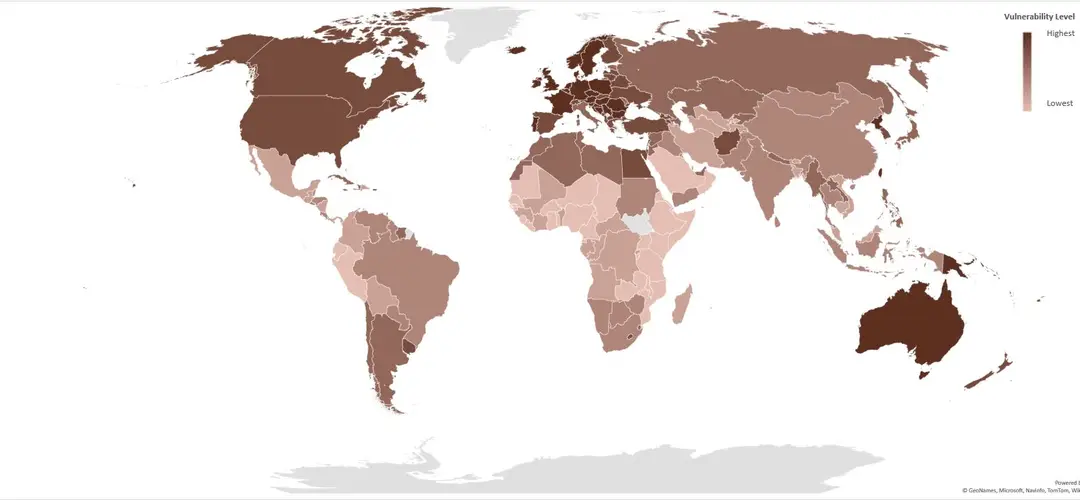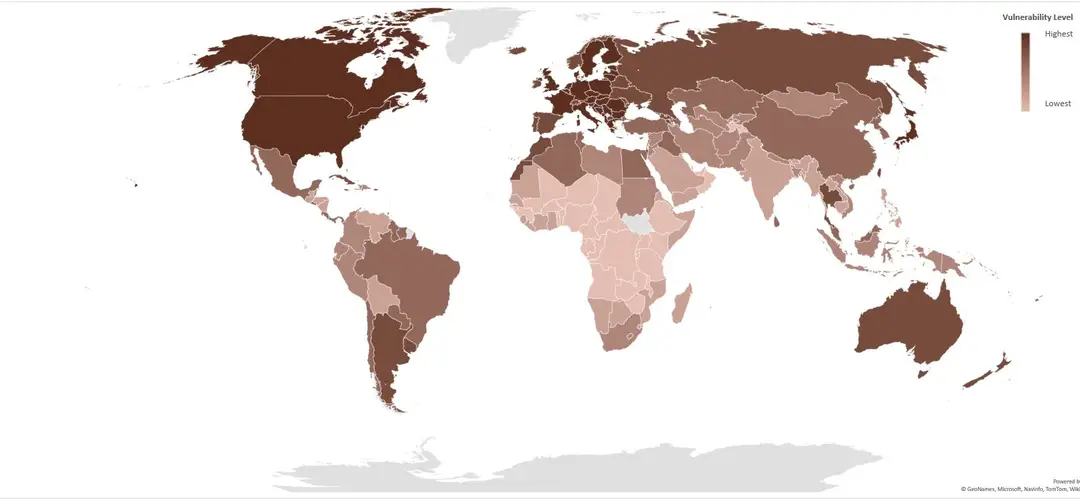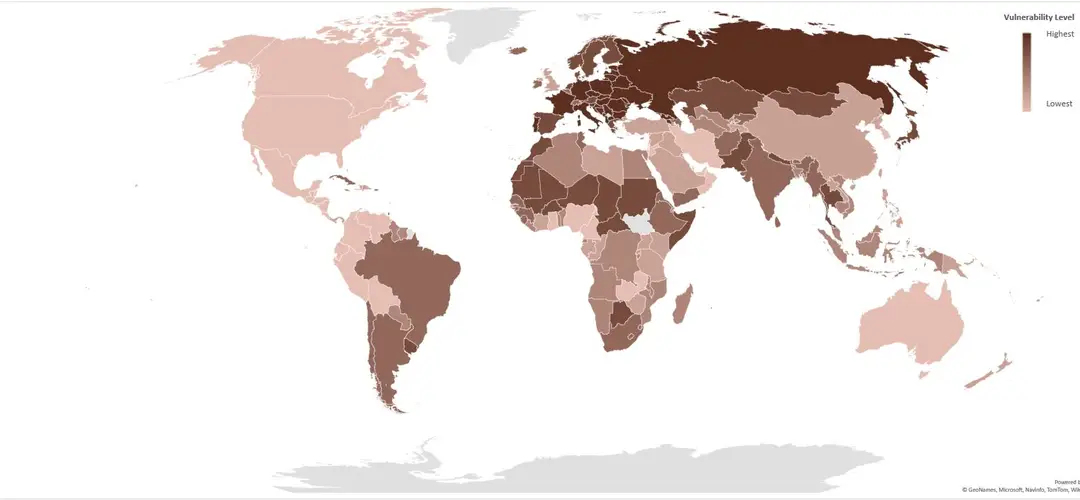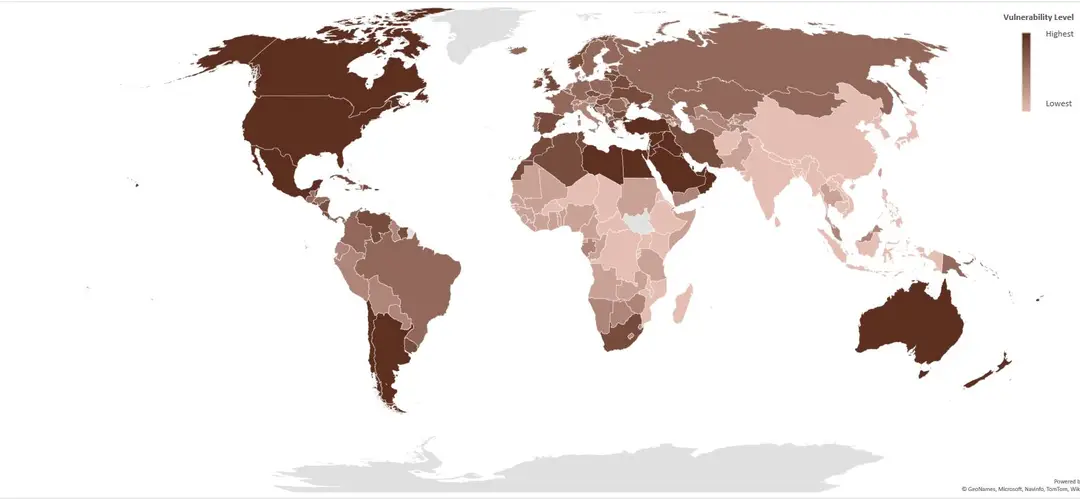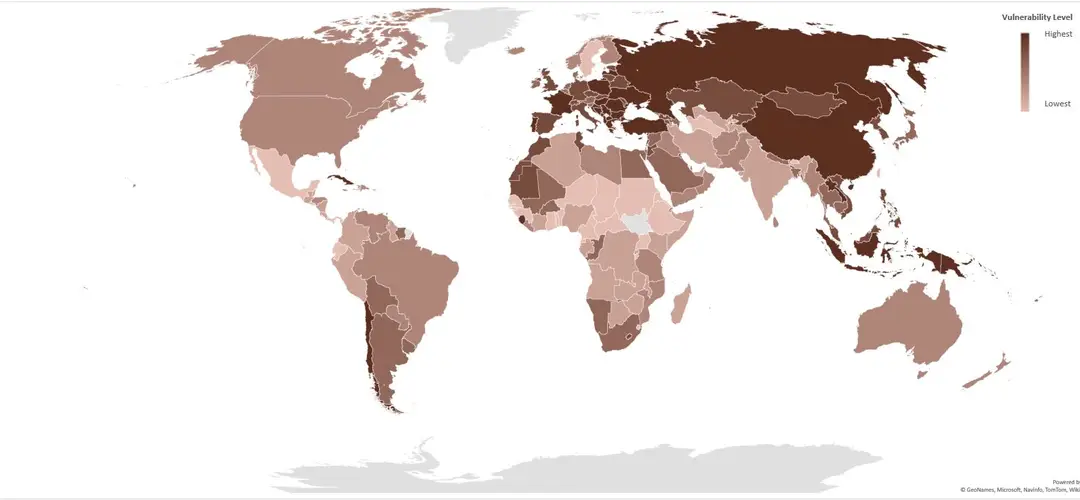Which countries are most vulnerable to severe cases of COVID-19? Part of the challenge in answering this question is better understanding the connection between this particular coronavirus and other major existing health risks. A significant proportion of the global population lives with noncommunicable diseases (NCDs) or NCD risk factors that increase the likelihood of hospitalization or death due to COVID-19, including chronic lung disease, hypertension, cardiovascular disease, diabetes, and obesity. The distribution of these conditions reveals dramatically different levels of underlying risk that can either worsen or enhance resilience against COVID-19.
Inspired by a map of the United States that PolicyMap produced for the New York Times, RTI’s Center for Global Noncommunicable Diseases created a world map (as seen below) to visualize COVID-19 vulnerability due to the underlying prevalence of NCDs and NCD risk factors. The team determined each country’s “overall vulnerability” to COVID-19 by assigning it a risk score based on the comparative prevalence of seven NCDs and NCD risk factors—diabetes, obesity, hypertension, daily smoking rates, lung disease, and cardiovascular disease.

NCD prevalence has increased dramatically in recent decades, including in low- and middle-income countries. Across North Africa, from Morocco to Egypt, high obesity and diabetes imply high COVID-19 vulnerability. Obesity and diabetes likewise elevate risk in South Africa and South America, especially Argentina and Chile. In Europe and Russia high population levels of hypertension, cardiovascular disease, and lung disease equate to high vulnerability to COVID-19. High rates of cardiovascular disease, lung disease, and obesity likewise exacerbate COVID-19 risk in the United States and Australia.
It is too early to say whether some underlying conditions are riskier than others, and we do not yet know whether there are less visible aspects of those diseases or other aspects of individual health status that determine which COVID-19 patients will suffer higher severity outcomes and probability of death. For now, the map assumes that each underlying condition contributes equally to COVID-19. The weighting can be adjusted in the future if new evidence indicates that certain chronic conditions have a larger impact on COVID-19 risk and severity of disease.
NCDs are not the only cause of COVID-19 vulnerability. As more data emerges from hospitals, we are beginning to perceive the wider factors that determine whether patients survive the virus, including blood type, the strength of health systems, socio-economic and nutritional status, and other yet to be documented factors. Living conditions, health system capacity, and policy decisions all play a part in determining how the pandemic unfolds around the world.
Understanding how the prevalence of NCDs contributes to COVID-19 vulnerability can help policymakers and health planners to anticipate what to expect and how best to respond. Countries with highly vulnerable populations must ready their health system to handle a possible rapid escalation of severe cases.
The world has been slow to take action on NCDs, even though NCDs are escalating across countries and already cause more than 70% of worldwide premature deaths, with 80% of these in low- and middle-income countries. A serious reckoning with the factors that increase risk of NCDs—unhealthy diets, physical inactivity, tobacco use, harmful alcohol use, and unhealthy air quality—would reduce COVID-19 vulnerability; lessen the devastating health, economic, and societal consequences of the pandemic; and immeasurably improve lives.
Curious about the global burden of specific NCDs and risk factors? Additional world maps can be found below:
Acknowledgements:
The authors would like to thank Donal Bisanzio, Angie Jackson-Morris, and Rachel Nugent for contributing to this piece.
Sources and methods:
This visualization combines prevalence data on diabetes, hypertension, and obesity from the NCD Risk Factor Collaboration, smoking rates from sources compiled by The Tobacco Atlas, and data on lung disease and cardiovascular disease from the Institute for Health Metrics and Evaluation. We assume that the available modeled estimates are a true reflection of population prevalence, and that prevalence of all conditions has remained similar since 2015, the year of these estimates. Our comparison does not include age as a separate risk factor. Given that many NCDs are more common in older people, national estimates already indirectly account for population age structures.
In order to assess overall COVID-19 vulnerability due to NCDs, we compared country prevalence of each NCD or NCD risk factor to the prevalence levels found in other countries throughout the world by assigning a rank of the prevalence level as a percentage of the data set. For example, if a country has a prevalence level of obesity greater than or equal to 80% of all other countries’ obesity prevalence levels, it is ranked in the 80th percentile. A country’s percentile ranking for each risk factor is split into levels representing very low, low, moderately low, moderately high, high, and very high risk, where each category is assigned a numerical value of one to six. A country’s overall vulnerability due to NCDs is assessed as the mean of a country’s individual NCD or NCD risk factor scores.


